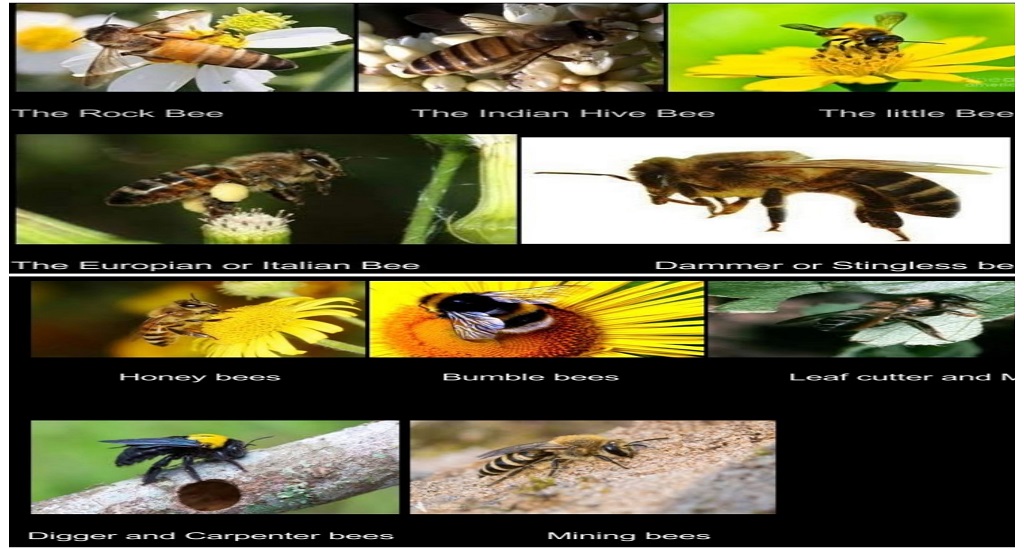Honey Bee: A Benefactor For Human Being

Dr. Sharyu V. Ghonmode
World honey bee day was first celebrated in 2009. Then after which the people were made aware regarding the benefits and environmental needs of honey bees. Today everyone knows the medical importance of honey. This National honey bee day is celebrated world wide by all honey lovers and bee keepers on the third Saturday in August every year. These honey bee lovers and beekeepers make people aware about the different types of honey bees, their behavioural pattern and also how one can provide them the supportive environment. No doubt that apart from obtaining honey people also have a great fear of getting sting. But this happens only when honey bees have a threat that their hives will get damaged.
Honey bees being the great pollinators depends on the variety of flowering plants, orchards and also different wild flowers for nectar. These honey bees due to their pollinating abilities helps to reproduce many nutritious plants. They are also useful in crop or agricultural pollination. According to studies, bees and other pollinators pollinate almost 90% of flowering plants and 70% of the world’s main crops. Without bees, these numbers would fall to decline.
Objective of National Honey Bee Day
The purpose of celebrating this day is to concede the importance of honey bees and other pollinators for our ecosystem.
Honey Bees Life
Apiculture is derived from the honey bees latin name Apis mellifera which means “honey gatherer”. The honey bees actually do not collect honey but they collect nectar from flowers from which they produce honey and so the name should be Apis mellifica which means “honey maker”. In the world there are approximately 20,000 different species which lives in honey bee hives prepared by them. They bear the caste system which comprise of a queen, workers, and drones. The worker is sterile female while the queen is fertile female who can reproduce and lay eggs. All drones are male. They mate with the queen. Worker bee’s clean the hive, collect the pollen and nectar to feed the colony and take care of the offspring.
Different species of honey bees
⦁ The Rock Bee
⦁ The Indian Hive Bee
⦁ The little Bee
⦁ The Europian or Italian Bee
⦁ Dammer or Stingless bee
Types of honey bees
There are various types of honey bees.
⦁ Honey bees
⦁ Bumble bees
⦁ Leaf cutter and Mason bees
⦁ Digger and Carpenter bees
⦁ Mining bees
Applications of honey
For centuries the honeybee acted as our benefactor and played a very significant role. From upper Paleolithic period, Stone age period, Neolithic and upto Bronze Age period giving much more importance to farming. The unprocessed honey is composed of nearly 200 substances like minerals, water, sugars, vitamins, enzymes, amino acids possessing anti-inflammatory, antimicrobial, antioxidant, ant metastatic, anticancer and anti proliferative properties because of the ingredients it possess.
Antioxidants
Free radical Scavengers which is a common name given to Antioxidants as it prevents or reduces the damage to cells caused by free radicals. Flavonoids and Polyphenols are found in honey which provides the antioxidant property. So these antioxidants help to eliminate the free radical which leads to aging and other diseases. Darker honey contains more antioxidants as compared to light coloured honey.
Anti-inflammatory
Compounds found in honey helps to reduce inflammation of cells. The inflammation may be acute lasting for small period or may be long lasing chronic inflammation. Honey helps in minimising the inflammation of gastrointestinal tract disorders, cancer, edema, cardiovascular diseases.
In diabetic persons honey can induce the reduction in plasma glucose level. It also helps to reduce blood lipids, homocysteine and C-reactive protein contents.
Antioxidants like Flavonoids, polyphenols, Vitamin C and monophenols found in honey bees may reduce the risk of blood clots and cardiovascular arrest
The polyphenols present in honey have neuroprotective in function and is thus beneficial in preventing memory disorders and induce memory productions.
Studies also indicate that consumption of honey may help to reduce asthma and bronchitis symptoms also inhalation of honey removes the mucus secreting goblet cell hyperplasia.
Research indicates that infants and small children given the oral rehydration therapy with honey shows that they recover from diarrhoea in less time period.
Apoptotic
Current studies reveal that honey may exert anticancer effects through several mechanisms. Honey helps to prevent the cell propagation, induce the cancerous cell death, modify cell cycle progression and cause the depolarisation of mitochondrial membrane in several types of cancer and tumour. Honey helps to regulate the apoptotic process in cancer cells.
Antimicrobial
Antibiotic –resistant infections are increasing day by day. This is of great concern for doctors. Honey has the inhibitory affects on some species of viruses, fungi and bacteria and by the consumption of honey the growth of these viruses, bacteria and fungi are inhibited.








